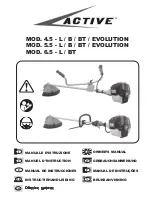
| 74 |
EN
8
Handling diamond dry-
cutting discs
•
Diamond dry-cutting discs must be stored,
handled and fitted carefully in accordance
w
ith
the manufacturer
’
s instructions.
•
Too soft diamond segments:
f
Diamond dry-cutting discs
w
ear too
q
uickly
at very high removal rate.
Remedy
: The material to be machined
re
q
uires diamond dry-cutting discs
w
ith a
harder bond.
•
Too hard diamond segments:
f
The diamond grains become blunt and do
not break out of the bond. The diamond dry-
cutting discs no longer have any cutting
po
w
er.
Remedy
: The material to be machined
re
q
uires diamond dry-cutting discs
w
ith a
softer bond.
•
In the event of loss in cutting po
w
er
(recognisable by intensity of flying sparks)
resharpen the diamond dry-cutting discs by
making several cuts in abrasive material, e.g.
sandstone.
•
Work
w
ithout applying pressure – the
w
eight of
the machine is sufficient. Increased pressure
causes increased
w
ear.
•
E
x
cessive cutting pressure can cause material
fatigue in the base metal and therefore the
formation of cracks. Before use, ensure that
there are no cracks in the diamond dry-cutting
disc.
•
Diamond dry-cutting discs are designed for
straight
cuts. If used to cut curves the blade
becomes deformed, causing internal cracks and
segments to break off (see “Chap. 3.5 Intended
use”) –
Risk of injury!
•
The diamond cutter should plunge into the
w
all
only after the
w
orking speed has been reached
– green LED (3) lights up.
•
After appro
x
. 2 minutes of cutting time the
machine should be run
w
ith no load for
10 seconds, so that the diamond dry-cutting
discs can cool.
9 Disposal
Recycle the machine and its packaging
in an environmentally friendly
w
ay in
accordance
w
ith the provisions applicable
in your country.
















































